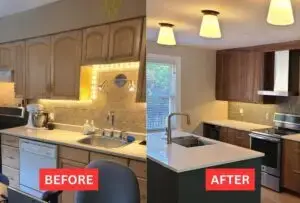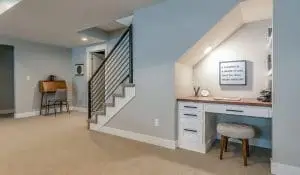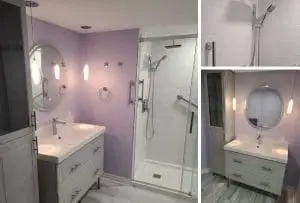Do you want to expand your kitchen space or make your current basement more functional? Do you want to start over and make a whole new living space or upgrade an existing one with contemporary elements? A home renovation project can be as simple as installing new windows and changing flooring or as complex as tearing down a wall.
To get started, picture your ideal beautiful, vibrant space and what it will look like.
Prioritize function: What do you plan to do in your kitchen renovation or when finishing the basement? There are countless ways to maximize the functionality of space with remodeling or renovation.
Improve energy efficiency: Going green in your home can help you save money on energy bills or make your home renovation options safer for your family.
Hire a designer: If your project is big, it would be much more cost-effective to work with a professional contractor. The experts can help bring your ideas to life and introduce you to new ideas that you might love.
 Image: Home renovation return on investment
If you are thinking about where to start, prioritize the kitchen. Kitchen renovations are the most complicated, and if you get done here, the rest of the upgrades are easy. The other reason is the home value of the kitchen renovation has a greater potential to improve home value compared to anywhere else in the house. Bathrooms and basements come in second.
Image: Home renovation return on investment
If you are thinking about where to start, prioritize the kitchen. Kitchen renovations are the most complicated, and if you get done here, the rest of the upgrades are easy. The other reason is the home value of the kitchen renovation has a greater potential to improve home value compared to anywhere else in the house. Bathrooms and basements come in second.
 Image: https://www.greedyrates.ca/blog/how-much-do-home-renovations-really-cost/
Image: https://www.greedyrates.ca/blog/how-much-do-home-renovations-really-cost/
Home Renovation or Remodel? Know the Differences
Everyone seems to use the terms “renovate” and “remodel” interchangeably. But they don’t mean the same thing. Remodeling is changing the look: Installing new counters, new cabinets, new hardware, new appliances, new flooring, paint, new items, etc. Renovating updates, the function: This includes all things in remodeling plus the demolition of walls, overhauling the floor, window frames, plumping structures, power installations, and gas, and the rearrangement of the entire space to fit your new objectives. Renovations are significant changes to the current space. Remodeling, while still a major project, usually retains the same kitchen designs. You must decide whether what you want to do is remodeling or renovation. It is possible to handle small remodeling projects on your own, but general contracting can save you time and money for extensive renovation projects.How to Go About Home Renovations
Find renovation ideas
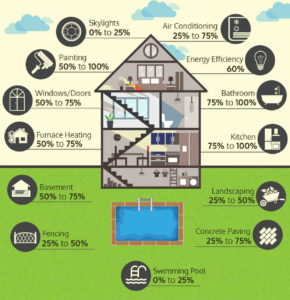 Image: Home renovation return on investment
If you are thinking about where to start, prioritize the kitchen. Kitchen renovations are the most complicated, and if you get done here, the rest of the upgrades are easy. The other reason is the home value of the kitchen renovation has a greater potential to improve home value compared to anywhere else in the house. Bathrooms and basements come in second.
Image: Home renovation return on investment
If you are thinking about where to start, prioritize the kitchen. Kitchen renovations are the most complicated, and if you get done here, the rest of the upgrades are easy. The other reason is the home value of the kitchen renovation has a greater potential to improve home value compared to anywhere else in the house. Bathrooms and basements come in second.
- Search online for the best renovation ideas within your budget and save the images in a ‘design ideas folder’ on your gadget.
- Consider home renovations that increase home resale value; including changes to flooring and walls
- Consider your comfort and the impression you want the home to have on your guests
- Take a tour of some of the local shops, showrooms, and home shows.
- Call a general contractor in Ottawa, or subcontractors for expert insight
Do the Math
Now that you have everything you need zoom in to what you can afford or is reasonable for your design objectives.Finishes & Repairs
The cost difference between custom and stock cabinets can be huge. It is the same for flooring materials and other design elements. Think about your style and budget and decide whether you need custom or stock to meet your goals.Create a Budget
You need a budget. Whether you earn a small income or have a substantial amount in your saving account, the budget keeps you, your designer, and your contractor on the right track. Not sure about the cost of remodeling your kitchen? Below We have listed average costs to help you get a good idea of how much your project will cost you.Average Renovation Costs
If you want a ballpark figure to help create your budget, we have some startup numbers. Below are the national average costs of kitchen renovations:General Cost of Kitchen Remodeling
The average cost of renovating a small kitchen is $ 21,185, and extensive renovations cost $ 55,503. However, these kitchen renovations increased the home resale value by $ 17,576 for a minor remodel and $ 43,363 for larger remodels. So, your cost will actually be $ 3,600 for small kitchen renovations and $ 12,000 for extensive renovations in these cases. Good math.Minor Kitchen Remodel
- Replace the front of the cabinet with new raised wooden drawers and doors, including the new hardware
- Replace wall-mounted ovens with new energy-saving features
- Replace laminate countertops; install a moderately priced sink and a tap
- Reset, add wallpaper and remove and lay down a solid floor
Mid-Range Kitchen Remodel
- Renovate a 200-square-foot kitchen with a functional 30-foot conventional custom cabinet made of wood cabinets, including a 3-meter-long island
- Replace laminate countertops
- Install a stainless-steel sink
- standard tap for single handle
- Replace energy-saving wall oven, cooking area, ventilation system, built-in microwave, dishwasher, garbage disposal, and custom lighting
- Install a new solid floor
- Finish with the painted walls, ceiling, and color
Major Kitchen Remodel – Upscale
- Upgrade a 200-square-foot kitchen with a 30-meter-high cherry cabinet top with shelves built into other interiors
- Replace laminate cabinets with stone countertops and ceramic or glass backsplash imported
- Install a built-in refrigerator, and 36-inch grade range and vent hood; built-in oven, garbage disposal, and integrated built-in microwave
- Install a low-rise sink faucet and add a built-in water filter
- Install new low voltage lamps under the cabinets
- Install cork flooring
Bathroom Remodels
A typical bathroom renovation involves updating vanities counter-tops and sinks. Re-tiling the walls, re-painting the walls, and changing the flooringUpgrading faucets and fixtures
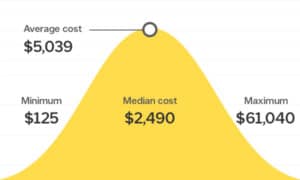 Image: https://www.greedyrates.ca/blog/how-much-do-home-renovations-really-cost/
Image: https://www.greedyrates.ca/blog/how-much-do-home-renovations-really-cost/
How to Pay Your Renovation Fees
Whether it’s a kitchen or bathroom renovation Ottawa, there are many ways you can pay for your project. One way is borrowing against your home’s value. There are also ways to borrow that do not rely on your credit history. Here are some of the options at your disposal.Home Equity Loans
Home equity loans are secured by your home’s appreciated value. The advantage is that your interest rate mortgage amount will not be increased.Homeowner’s Loan
You are borrowing against your income and not the home’s value. Your home will be the collateral, but this is good for those new to homeowners with a healthy income.Value Added Loans
If you are making significant improvements, you can borrow from what will be worth your home after the project instead of its current value. You Need a Timeline Finally, when do you want to start working, and when do you want your basement remodel be completed? Ensure that your home renovation contractors understand your timelines.Home Renovation Project Stages
Choosing and Interviewing a Contractor
Once you have your list of qualified pros, you should make sure that you are consistent when interviewing them. Questions that homeowners must ask a contractor should revolve around:- List of references
- Portfolio of past projects
- Overview of costs
- Payment terms and schedule
How to analyze quotes
There is a big difference between a “free” one-paragraph quote and one five-page length statement with all aspects of the project explained. Get every detail on paper! This is also an excellent time to see if you can work with your contractor – are they willing to take time to enlighten you about the process and all your options? What does the contractor’s quote say about cost overruns? Does the stated amount cover everything? What about design, permits, and drawings – is it all in the quote? Don’t assume anything; if the quote allows for $ 3,000 cabinets, ask your contractor to show you what the $ 3,000 cabinets look like. This will save you from nasty surprises down the road. But remember that money is not everything! Do you like and trust the contractor? Is there anything fishy about them? Trust your instincts and hire only someone who feels right to you.Hiring a Contractor
You’ve done all due diligence and decided on a contractor you like. Despite the progress, you still have work to do to ensure that you enter the right relationship.- Confirm that whoever you are speaking to works for the contractor company
- Ask for a copy of the contractor company license.
- Ask for a copy of the insurance documents.
- Choosing a Contractor – Contracts
- Now, you need to make sure the contract terms are in line with your expectations
What a Good Contract Should Have
- It should include a detailed description of the work to be done
- It should be drawn on the company letterhead.
- It must contain the company’s name, address, telephone number, and license number.
- Provides a payment plan
- Includes a termination clause
- Provides dollar costs associated with each project included in the project
- Includes expected date / start / estimated date
- It clearly states whether permits will be needed and who will be responsible for getting them
During the Construction
The moment you have planned the work and laid down the basic rules, you now need to put on your manager’s project hat. One way to keep things in perspective and stay informed is to have regular progress meetings with your project manager or contractor. Progress meeting is a time for reviewing questions, making decisions, and discussing changes in the scope of the project. You can have these meetings daily or once a week for prolonged projects. Have your contract copy with you in these meetings and take advantage of the forum to express concerns or make changes.Payment Schedule
The rules are not etched in stone. There are many ways a contractor collects his money. Some do not collect until the work is completed, while others request 50 percent earlier. These are the three types of payments:- Initial payment is usually made when bulk items are shipped
- The second payment is made when work is half complete
- Another 20% when the work is almost completed
- Pay the company, not an individual.
- Don’t pay cash. Write a check or pay with a credit card and get receipts.
- Only make the final payment when satisfied with a project.
- Do not advance funds for materials.
House Rules for Constructors
It may difficult to live in the house when parts of it are under construction. If it’s a kitchen renovation, you may have to order takeout or go without a meal. But things don’t have to be unbearable. Here are some of the things to remember to help make the home renovation a smooth process: 1 a) Remove everything that you don’t frequently use from the kitchen or basement during the renovation. 1 b) Make a map of the route the contractors should take from the entrance to the project area and secure the floor with old towels, carpets, or plastic. 1 c) Note that temporary disruption such as when the constructors arrive early or stay late may help accelerate the project. 1 d) Decide what to do with your cats and dogs so that they do not get in the way of a contractor. 1 e) Choose whether you want the home cleaned every day. Remember that for extensive projects, cleaning every day can prolong completion timelines. 1 f) Plan where the contractors will park, and if necessary, and where construction waste will go. 1 g) Decide how you want to start and complete work each day and whether you will be able to work on the weekends. 1 h) During construction, plan well on how to decrease the amount of dust – put plastic covers on the door to keep out dust. 1 i) Choose where they’ll get their electricity. 1 j) Give the workers refreshments if possible. 1 k) Coffee can motivate home renovation contractors to work better and faster.Change Orders
A change order is a written request to change the work scope specified in your contract or plans. There are two types of change orders: those you initiate and those contractors initiate due to unexpected build conditions. While this type of change order can be much frustrating, it’s an inevitable part of home renovations, and having a well-defined policy change for your contract can streamline this process.A typical change order must include the following:
- Username, phone number, and address
- Name of owner
- A complete description of the new work to be done
- Total number of building materials and personnel to complete the transformation
- Updated graduation date due to replacement
- Signatures of the company representative
- Signatures of homeowners
Punch Lists
The punch list is a checklist for all incomplete project-related items. It is a good idea to review and share this list of your progress meetings to guarantee that you read from the same script as the constructors. This document acts as a “What’s left” list. Once the contractor has completed work on all the items on your punch list to your satisfaction, you should pay the remaining amount you owe and open a bottle of wine!Inspection and Completion
After the project completion, you and your contractor should schedule an inspection to review all contractual elements, change orders, and your punch list. You may likely have a few highlights or changes you want at this point, and these should be added to the punch list and tied to the final payment.Design Ideas
Traditional
With a solid base of cabinets with furniture and vanity styles, traditional style is often expanded with lines of decorative plumbing and appliances and complemented by the warm yet subtle colors as well as beautiful shapes.Contemporary
This style is marked with sharp lines sharp, minimalism, and an oriental effect. Modern kitchens often have various unique materials and smooth surfaces, such as concrete, wrought iron, and brass.Country
This style draws on the old school and uses nature to incorporate the original feel. The layout is simple and low, from rough wood-hewn wooden floors to floral designs and earthy colors.Transitional
Transitional style fills the space between Traditional and Contemporary by softening the modern industrial feel with rounded corners and warm colors while maintaining the sensitivity of Contemporary design.Tips to improve your style:
- Align changes with the style and feel of other rooms in your home.
- The kitchen style should match the style and time in which the house is built/decorated.
- Imagine you are sitting in the final space after a home renovation – what colors and objects do you see?
- Keep it simple and tasty, and don’t cut corners with details.
- Don’t go too far out of your comfort zone


